Following the appointment of architect's Fender Katsalidis to design Parramatta's latest office development, the GPT group have submitted a development application to the City of Parramatta.
The diversified real estate investment trust will redevelop a collection of existing structures at 93-95 Phillip Street and 32 Smith Street into one super site for a new commercial building.
Related reading: ‘Translucent’ Building Wins Design Competition For $230 Million Parramatta Tower
The Urban Developer spoke with GPT Group's senior development manager David Flannery and head of office and logistics Matthew Faddy, Urbis' associate director Alison Brown and principal at Fender Katsalidis Mark Curzon to gain a greater insight into what informed GPT's Smith Street development application.
GPT’s head of office and logistics Matthew Faddy
believes the Parramatta CBD over the past two decades has shown significant promise, yet has been difficult to execute on. Adding that the general consensus suggests the office market has finally arrived after a long period of built up hype.
"Keys deals including the Western Sydney University taking 26,000 square meters, NAB 35,000 square meters and the Department of Education taking 25,000 square meters have driven the strong demand and creation of quality product in this market.
"Recent statistics show demand for office space -- and particularly high-grade space -- in Parramatta is already outstripping supply. For the first six months of 2017, the total vacancy rate for office space in the Parramatta CBD, according to the Property Council, was 4.3 per cent which was the second lowest rate in the country – and compares to the 5.9 per cent rate in the Sydney CBD." Faddy said.
While the vacancy rate for A Grade office space in Parramatta strengthened GPT’s decision to develop 32 Smith Street, Faddy also cited infrastructure growth and the $2 billion Parramatta Square development as a major catalyst of the transformation of Parramatta.
Related reading: Parramatta Square: An Insight Into Parramatta’s $2 Billion Urban Renewal

These are sentiments shared by Urbis associate director Alison Brown who was a part of the planning team behind the Smith Street development proposal.
"The long touted idea of Parramatta as Sydney’s second CBD seems to be finally taking off. All the stars are aligning with Parramatta Square, the Museum of Applied Arts and Sciences, Parramatta Stadium, the Light Rail, Metro West, the Greater Sydney Commission's focus on GPOP and the Greater Parramatta Priority Growth Area," Brown said.
Related reading: Greater Sydney Commission’s Plan For Three Cities By 2040
Brown applauds the collaborative approach of the Parramatta City Council: "Parramatta City Council really walks the talk in relation to supporting quality commercial office development in the CBD, through their city significant project team, city architect, and design excellence process and bonuses."Yet Brown cautions that despite all the optimism there is still much work to be done -- explaining that the success of the Parramatta CBD and the supporting precincts depends on a continued investment in social, cultural, community, educational and recreational infrastructure.
There is a marked deficit in provision per capita in western Sydney compared with the east, which will become more significant in coming years if decisive action is not taken. We must also address the issue of planning certainty, mooted levies and charges, and the inordinate time taken to progress strategic planning changes."
"Fortunately in this case, GPT was determined to push on under the existing controls rather than wait for an increase in height and FSR that may be still be years away. Uncertainty about the future planning framework was actually embraced by GPT and the architect in the design.
"The car park floor to floor height, lifts and services are designed to enable future conversion of above ground car parking levels to office space, as technology and public transport improvements lead to reduced demand for private parking. Additional floor space could be approved when the proposed commercial FSR bonus provisions are in place." Brown said.

The Smith Street site plays a pivotal part in the development of Parramatta's CBD and is situated directly across from the transformative museum and cultural precinct and the proposed $100 million MAAS development.
GPT Group's senior development manager David Flannery
said that when GPT purchased the site it was heavily rumoured that the MAAS would relocate to Parramatta and in doing so would be located on the site diagonally opposite.
"Whilst this factored into our thinking and the brief we issued to the architects prior to the design competition, it was really a stroke of genius by Fender Katsalidis that embraced this in their design when the site for MAAS was confirmed." Flannery said.
Through a series of massing studies, project architects Fender Katsalidis developed a strategy of elevating the tower from the sites corner to open up the public realm -- creating a direct link to the MAAS development and cultural precinct and connection to the river.
"The site is strategically located on the primary north-south axis, acting as the northern gateway to Parramatta. The site has the potential to strengthen the connection between the river and the city centre" Fender Katsalidis principal Mark Curzon said.
Curzon said that the ground floor evolved around these two main principles and by setting back the podium on the corner it provides a strong visual connection from Smith Street to the river via George Khattar Lane.
Flannery said GPT Group were looking forward to receiving development consent and delivering 32 Smith Street to the market.
“There is no building like this in Parramatta and we therefore see it as the new benchmark,” he said.
GPT estimates the entire project will cost over $115 million.
Images courtesy Fender Katsalidis Architects via City of Parramatta.














